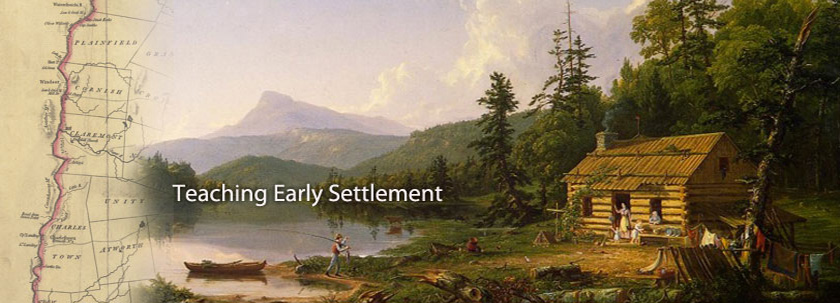- Who first lived in this area we now call Vermont/New Hampshire?
- Where did the first European settlers come from? Why did they come to this area?
- Who settled here and how did they live?
- What did they do to organize their towns?
Unit Frame
| Topic/Title | Early Settlement of the in the Connecticut River Valley (1750 to 1800) |
| Overview | The purpose of this unit is to study the early settlement of the Upper Connecticut River Valley using primary sources and the landscape. Students follow an inquiry model where they gain background knowledge to the topic, generate questions about the people who settled this region, and then launch an historical investigation culminating in a historical cemetery quest that they can share with their community. |
| Enduring Understandings |
|
| Essential Question | What is the relationship between culture, humans, and geography? |
| Focusing Questions |
|
| Content Grade Expectations for Vermont | |
H&SS3-4:8 Students connect the past with the present by…
|
|
H&SS3-4:9 Students show understanding of how humans interpret history by…
|
|
H&SS3-4:12 Students show understanding of human interaction with the environment over time by…
|
|
H&SS3-4:11 Students interpret geography and solve geographic problems by…
|
|
| Inquiry Grade Expectations for Vermont | |
| Students initiate an inquiry by. Asking relevant and focusing questions based on what they have seen, what they have read, what they have listened to, and/or what they have researched. |
|
| New Hampshire Curriculum Framework: Social Studies | |
| SS:CV:6:2.2: Identify and illustrate the heritage that early settlers brought to the development and establishment of American democracy, e.g., political, legal, philosophical, or religious traditions. (Themes: E: Cultural Development, Interaction, and Change) | |
| SS:GE:6:4.4: Analyze the spatial patterns of settlement, e.g., urbanization along river, agriculture on fertile plains, or nomadic lifestyles in steppes and deserts. (Themes: C: People, Places and Environment, E: Cultural Development, Interaction, and Change) | |
|
Thanks to Steve Glazer of Poetics of Place, classroom teachers Marguerite Ames and Bridget Fariel, and Beth Hughes of Broadwing Design for assistance in designing this toolkit. |
|
